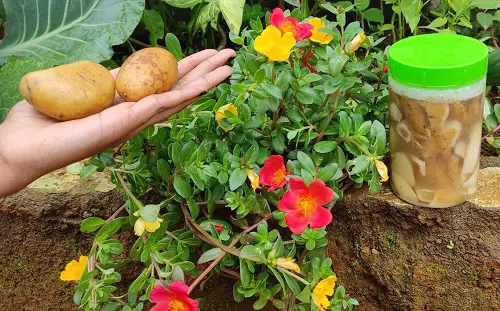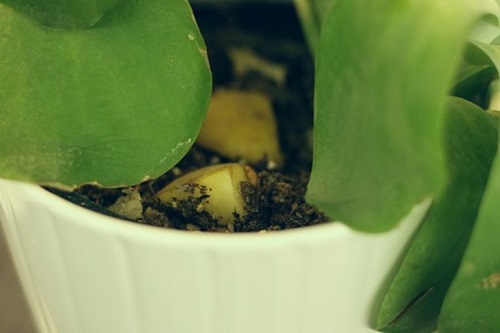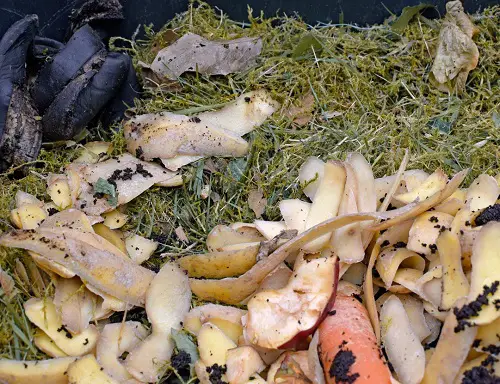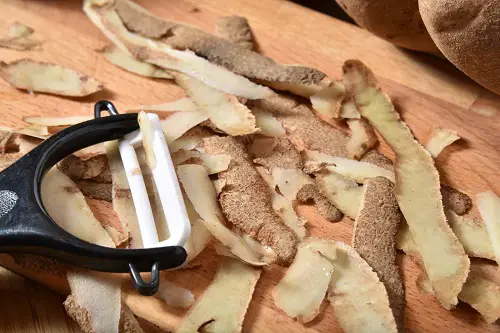Discover 6 Surprising Potato Peels and Slices Uses in the Garden that will surely blow your mind. After all, everything is useful in the garden.
If you have leftover potatoes, slices, and peels. Don’t toss them hastily! Maybe you compost them, but there are other great uses you should know about, and they are listed below.
Have a look at the banana peel uses in the garden
Surprising Potato Peels and Slices Uses in the Garden
1. Use Them in Composting
Potato peels, as well as other vegetable scraps, are a great addition to your compost pile. They are high in nitrogen, which helps to speed up the decomposition process.
In addition to nitrogen, potato peels also contain phosphorus, potassium, and calcium, all of which are important for plant growth.
2. Can Be a Great Fertilizer!

Potato peels and potato water act as natural fertilizers for plants. Potato water, which is the water left over after boiling potatoes, contains valuable nutrients such as potassium, phosphorus, and nitrogen.
The exact NPK ratio can vary depending on the type of potato and how you prepare it, but it is generally in the range of 0.5-0.1-0.1 (N-P-K).
- The potassium in potato water is important for plant growth. It helps to promote strong root development and disease resistance, while phosphorus is essential for root development, seed formation, and photosynthesis.
- Nitrogen is a key component of chlorophyll, which is necessary for photosynthesis and healthy plant growth. Potato water is particularly beneficial for plants that thrive in acidic soil, such as tomatoes, peppers, and blueberries, as it is slightly acidic.
- Potato peels are also a good source of nutrients, with an NPK ratio of around 1-0.5-3. They are high in organic matter, which helps to improve soil structure and fertility, making it easier for plants to take up nutrients and water.
- Nitrogen in potato peels helps to promote healthy plant growth, while phosphorus is important for root development and seed formation. Potassium is necessary for healthy growth and helps to promote disease resistance and water uptake in plants.
Note: When using potato water and peels as fertilizer, it’s important to dilute the potato water (With water in the ratio of 1:1) and use it in moderation to avoid over-fertilization, which can lead to nutrient burn and other plant problems.
3. Helps to Keep Fungus Gnats At Bay

Slices of raw potato can be used to control fungus gnats. The potato slices attract the gnats, which will lay their eggs on them.
After a few days, remove the potato slices and dispose of them. The eggs will be removed with the potato slices, and the gnats will no longer be a problem. If you want, there are more ways to get rid of gnats here.
Read about the Citrus Peel Uses In Garden
4. Can Be an Organic Seed Starter
Potatoes can be used as a biodegradable seed starter. Cut a potato in half, carve out a small well in the middle, and add soil and a seed.
Once the seedling grows, you can transplant the potato into your garden soil.
Potatoes are rich in nutrients, and as the potato decomposes, it releases those nutrients back into the soil, which will help to nourish that plant.
5. Use the Peels as a Slug Bait
Potato skins can be used as slug bait. Slugs are attracted to the moisture in the potato skins and will crawl inside the skin to feed.
In the morning, remove the potato skins and dispose of them, along with the slugs.
6. They are Fantastic Soil Amendment

Potato peels are super amendments to improve soil structure and fertility. They contain a high percentage of organic matter, which can help to improve the soil’s ability to retain moisture and nutrients.
In addition, potato peels are rich in nitrogen, phosphorus, and potassium, all of which are important for plant growth.
In summary, leftover potatoes can be a valuable resource for gardeners. They can improve soil structure and fertility, provide nutrients to plants, and control pests such as fungus gnats and slugs. By repurposing your leftover potatoes, you can help to reduce waste and create a more sustainable garden.




